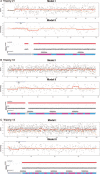Analysis of 17,428 pregnant women undergoing non-invasive prenatal testing for fetal chromosome in Northeast China
- PMID: 33578623
- PMCID: PMC10545248
- DOI: 10.1097/MD.0000000000024740
Analysis of 17,428 pregnant women undergoing non-invasive prenatal testing for fetal chromosome in Northeast China
Abstract
Non-invasive prenatal testing (NIPT) is an incomparable prenatal screening technology, but we should undergo amniocentesis to confirm fetal chromosome when pregnancies receive a positive result via NIPT. We aimed to investigate the detection rate and positive predictive value of NIPT results in pregnancies from Northeast China, and to determine the reasons for false positive and false negative NIPT results.This study evaluates 17,428 singleton pregnancies had undergone NIPT detection. 202 samples were NIPT positive with the detection rate was 1.16% (202/17,428). Among all the positive samples, 160 samples (79.21%) were referred for an amniocentesis procedure to investigate the fetal chromosome. The positive predictive value of T21, T18, and T13 was found to be 75% with a 0.07% false positive rate. Positive predictive value from high to low was as follows: trisomy 21 (84.38%), followed by trisomy 18 (61.54%), autosomal abnormalities (52.94%), sex chromosomal abnormalities (38.46%), and trisomy 13 (33.33%). The positive predictive values for sex chromosome abnormalities turned out to be mosaic sex chromosome aneuploidies (83.33%), followed by XYY (57.14%), XXY (37.50%), XXX (36.36%), and Monosomy X (28.95%). Out of the 160 samples had amniocentesis, the true positive cases in trisomy 21 had a higher percentage of Z-scores compared with the false positive cases in trisomy 21 (P < .05). And the true positive cases in trisomy 18 had a significantly higher percentage of Z-scores compared with the false positive cases in trisomy 18 (P < .01).These findings indicate that the positive predictive value of T21, T18, and T13 was found to be 75% with a 0.07% false positive rate. It is worth noting that the positive predictive value of NIPT for autosomes and sex chromosomes. Moreover, if women receive a positive result via NIPT, they should pay attention to the results with undergoing further prenatal diagnosis.
Copyright © 2021 the Author(s). Published by Wolters Kluwer Health, Inc.
Conflict of interest statement
The authors have no conflicts of interests to disclose.
Figures


Similar articles
-
Non-invasive prenatal test findings in 41,819 pregnant women: results from a clinical laboratory in southern China.Arch Gynecol Obstet. 2023 Sep;308(3):787-795. doi: 10.1007/s00404-022-06908-3. Epub 2023 Jan 5. Arch Gynecol Obstet. 2023. PMID: 36602559 Review.
-
Clinical Application of Cell-Free DNA Sequencing-Based Noninvasive Prenatal Testing for Trisomies 21, 18, 13 and Sex Chromosome Aneuploidy in a Mixed-Risk Population in Iran.Fetal Diagn Ther. 2020;47(3):220-227. doi: 10.1159/000501014. Epub 2019 Sep 5. Fetal Diagn Ther. 2020. PMID: 31487708
-
Clinical application of expanded noninvasive prenatal testing for fetal chromosome abnormalities in a cohort of 39,580 pregnancies.Am J Med Genet A. 2022 May;188(5):1426-1434. doi: 10.1002/ajmg.a.62657. Epub 2022 Feb 2. Am J Med Genet A. 2022. PMID: 35107205
-
An assessment of the analytical performance of non-invasive prenatal testing (NIPT) in detecting sex chromosome aneuploidies: 34,717-patient sample in a single prenatal diagnosis Centre in China.J Gene Med. 2021 Sep;23(9):e3362. doi: 10.1002/jgm.3362. Epub 2021 Jun 14. J Gene Med. 2021. PMID: 33973298
-
Systematic Review of Accuracy Differences in NIPT Methods for Common Aneuploidy Screening.J Clin Med. 2025 Apr 18;14(8):2813. doi: 10.3390/jcm14082813. J Clin Med. 2025. PMID: 40283645 Free PMC article. Review.
Cited by
-
Performance of cell free DNA as a screening tool based on the results of first trimester screening.Mol Cytogenet. 2024 Dec 20;17(1):33. doi: 10.1186/s13039-024-00702-3. Mol Cytogenet. 2024. PMID: 39707390 Free PMC article.
-
Study protocol for a descriptive analysis of non-invasive prenatal testing uptake and performance in singleton and twin pregnancies using Ontario birth registry data.BMJ Open. 2025 May 14;15(5):e095318. doi: 10.1136/bmjopen-2024-095318. BMJ Open. 2025. PMID: 40374222 Free PMC article.
-
The Impact of Chromosomal Mosaicisms on Prenatal Diagnosis and Genetic Counseling-A Narrative Review.J Pers Med. 2024 Jul 21;14(7):774. doi: 10.3390/jpm14070774. J Pers Med. 2024. PMID: 39064028 Free PMC article. Review.
-
Non-Invasive Prenatal Testing (NIPT): Reliability, Challenges, and Future Directions.Diagnostics (Basel). 2023 Aug 2;13(15):2570. doi: 10.3390/diagnostics13152570. Diagnostics (Basel). 2023. PMID: 37568933 Free PMC article. Review.
-
A Critical Evaluation of Validation and Clinical Experience Studies in Non-Invasive Prenatal Testing for Trisomies 21, 18, and 13 and Monosomy X.J Clin Med. 2022 Aug 15;11(16):4760. doi: 10.3390/jcm11164760. J Clin Med. 2022. PMID: 36012999 Free PMC article.
References
-
- Lo YM, Corbetta N, Chamberlain PF, et al. . Presence of fetal DNA in maternal plasma and serum. Lancet 1997;350:485–7. - PubMed
-
- Hartwig TS, Ambye L, Sørensen S, et al. . Discordant non-invasive prenatal testing (NIPT) - a systematic review. Prenat Diagn 2017;37:527–39. - PubMed
-
- Benn P, Borrell A, Chiu RW, et al. . Position statement from the Chromosome Abnormality Screening Committee on behalf of the Board of the International Society for Prenatal Diagnosis. Prenat Diagn 2015;35:725–34. - PubMed
-
- Di Renzo GC, Bartha JL, Bilardo CM. Expanding the indications for cell-free DNA in the maternal circulation: clinical considerations and implications. Am J Obstet Gynecol 2019;220:537–42. - PubMed
-
- Shaw J, Scotchman E, Chandler N, et al. . Non-invasive prenatal testing for aneuploidy, copy number variants and single gene disorders. Reproduction 2020;1. - PubMed
Publication types
MeSH terms
Grants and funding
LinkOut - more resources
Full Text Sources
Other Literature Sources

